Isabella Bradford's Blog, page 64
January 31, 2016
Fashions for February 1812
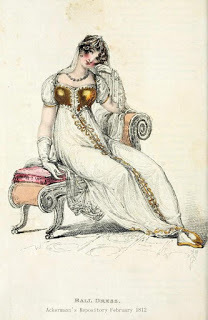 Ball Dress February 1812
Loretta reports:
Ball Dress February 1812
Loretta reports:Though I took a detour to 1836 for last month's fashion plate , in order to illustrate my latest book, I’m hoping this year to show you the evolution of style, decade by decade. Of course, if something irresistibly fabulous turns up in the “wrong” era, we’ll make another detour.
But today we’re looking at Regency—interpreting the term very narrowly this time as the period from 1811 to 1820, when the Prince of Wales became Prince Regent because the reigning monarch, King George III, was too ill to rule. (Social historians and others, however, tend to refer to a broader period, which Wikipedia concisely summarizes here , in the second paragraph.)
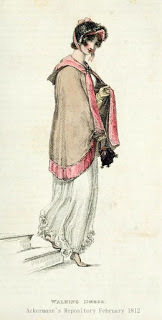 Walking Dress February 1812
Walking Dress February 1812
These two dresses, though, fall smack dab into the Prince Regent’s time, with the classic vertical muslin styles we associate with Pride and Prejudice , and which happen to be illustrated in especially beautiful prints in Ackermann’s Repository.
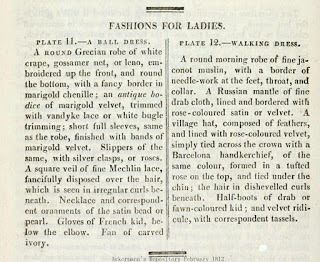 Dress Description February 1812
Dress Description February 1812
I would call your attention to the description of the hat, which I would love to see in real life.
Clicking on the image will enlarge it. Clicking on the caption will take you to the source, where you can learn more and enlarge images as needed.
Published on January 31, 2016 21:30
January 30, 2016
Breakfast Links: Week of January 25, 2016
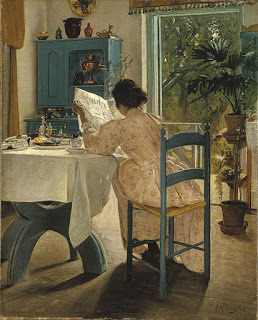 Breakfast Links are served - our weekly round-up of fav links to other web sites, articles, blogs, and images via Twitter.
Breakfast Links are served - our weekly round-up of fav links to other web sites, articles, blogs, and images via Twitter.• Intriguing book digitalized for online reading: Barrington's New London Spy for 1809, or, The Frauds of London Detected.
• Which came first: the product or the L'eggs ?
• Smoking little Josiah: mandatory fumigating with brimstone against smallpox in 1775 Boston.
• Amelia Earhart's cautiously optimistic advice to an aspiring female pilot in 1933.
• Looking closely at a young New York woman's early 19thc. diary .
• Image: Another needlework pattern - for aprons or neckerchiefs - from the Lady's Magazine, 1786.
• Posthumous portraiture in 19thc. America.
• The unexpected beauty to be found in America's last surviving textile mills .
• Remains of an early African-American burial ground discovered in NYC beneath a Harlem bus station.
• Lustful looks: signs of venery in John Ward's 17thc diaries.
• Image: The Swell's Night Guide to the Bowers of Venus.
• Brighten up a dull winter day by carrying a little bouquet of bright flowers in this 19thc silver holder .
• Mr. A. Watkins and the touring bee van .
• Why (and how) does an 18thc fictional character have a grave in the cemetery of NYC's Trinity Church?
• Ranch dressing: what to wear to a dude ranch in the 1930s.
• Image: Tudor rose , Canterbury Cathedral.
• A mysterious ritual burial for two horses killed serving in the War of 1812.
• The arches of Madison Square Park in New York.
• Paper dolls and ready-to-wear brought flapper fashions to the masses in the 1920s.
• Monsters and moral panic in 18th-19thc London.
• The kitchen is the heart of the home: why these two slave cabins matter.
• Image: When you want to fight, but your horses just want to hug it out.
• Life in the King's Bench Prison .
• What they left behind : things people keep to remember their deceased loved ones.
• Somewhere between history and style: the eccentric beauty of Malplaquet House .
• Just for fun: "When you're rich, and when you're poor" from Mad Magazine, 1977, and still too true.
Hungry for more? Follow us on Twitter @2nerdyhistgirls for fresh updates daily.
Above: At Breakfast by Laurits Andersen Ring. Private collection.
Published on January 30, 2016 14:00
January 28, 2016
Friday Video: Sights and Sounds of Paris in the 1700s
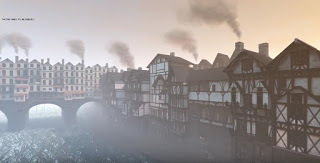 Loretta reports:
Loretta reports:The closest we Nerdy History Girls come to time travel is exercising our imaginations, based on what we find in historical materials. As to actual time travel—I’m not sure I want to go there without inoculations against a host of diseases. Also, I’m not sure how well I’d cope with the smells. My fantasy is a sort of bubble, in which I’m invisible to others, and which contains a translation device that allows me to understand what people are saying. This would include speakers of English, whose pronunciation not only varies depending on locale, but has also changed over time.
While not in English, this video gives a hint of what it might be like in that bubble, walking through a part of Paris in the 1700s.*
*My thanks to author Lauren Willig, whose Facebook post I stole it from.
Readers who receive our blog via email might see a rectangle, square, or nothing where the video ought to be. To watch the video, please click on the title to this post.
Published on January 28, 2016 21:30
January 27, 2016
Saving Local History and the 18thc Covered Wagon Inn
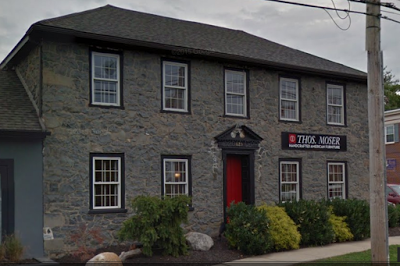 Isabella reporting,
Isabella reporting,I live in Chester County, Pennsylvania, not far from Philadelphia. Independence Hall, Carpenters' Hall, and the Liberty Bell are forty or so miles to the east, and Valley Forge National Park is the proverbial stone's throw away.
Although the county is a region almost embarrassingly rich in 18thc. history, there aren't as many surviving buildings as you might think. Part of this is the nature of that past - most of 18thc. Chester County was farmland - plus the usual hazards to old structures of fire and strong weather, but the largest threat has always been progress. Just as that 17thc. developer William Penn looked at the colonial wilderness and envisioned his famous "Green Countrie Townes" replacing forests, so his later counterparts were - and are - every bit as eager to wipe out yesterday for the sake of a more profitable present.
The photograph, above, shows the Covered Wagon Inn in Strafford, PA, built around 1780 as a way station for travelers and commercial traffic on the busy road between Philadelphia and Lancaster. Beyond that, it's not famous. It doesn't have landmark status. It's not even a particularly striking example of vernacular architecture, and besides, the interiors were gutted long ago to convert it into a modern restaurant (it's currently the showroom for a furniture maker.) But the Inn is a tangible link to a long-gone Chester County, and a vivid reminder that, however fast we're whizzing along Route 30 today, we're only about seven generations removed from the 18thc. Pennsylvanians who stopped here for a meal and to water their horses.
It's also a reminder that may soon be gone. The Covered Wagon Inn has the misfortune to sit on a valuable corner lot, and there are plans to replace it with a CVS drug store. Although the lot is large enough to work around the Inn, the CVS representatives are adamant: they want that corner so the new store can have a drive-thru window. They can't see an imaginative way to incorporate the old Inn into their plans. Their architect promises to honor the memory of the old inn by incorporating a stone wall into the store's design.
That's not enough. Surprisingly, local preservation laws to save the Inn don't exist. But people who care about local history are trying to persuade the town supervisors, the real estate company holding the property, and CVS to change their plans and save the Inn. No one expects a historically accurate restoration or recreation, but rather a historically sensitive plan to preserve and incorporate the Inn into a modern commercial use for the corner. You can read more about the efforts here . You can follow the Inn on Facebook here , and you can sign the Change petition here . I'd appreciate it if you do.
But more importantly, I hope you'll take a long look at the links to the past in your own neighborhood. So many need your help, and perseverance and creative thinking are the only ways to keep the past as part of the present, and the future. Because once that old house, or shop, or tavern, or mill, or bridge, or whatever it may be, is gone, it's gone forever.
Above: The Covered Wagon Inn, photograph via Google street view.
Published on January 27, 2016 21:00
January 25, 2016
Mr. Curtis's Acoustic Chair
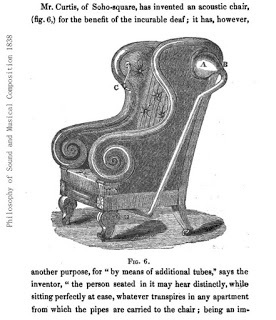 Curtis's Acoustic Chair
Loretta reports:
Curtis's Acoustic Chair
Loretta reports:While researching another topic entirely, I came upon Mr. Curtis’s Acoustic Chair. This is another of the items that were familiar enough to people at the time to become the subject of witticisms, while being completely new to me.
“Mr. Curtis, about 1830, by the aid of several mechanics, brought out his acoustic chair, which was stated to possess such wondrous power, that His Majesty could sit in his palace, at Windsor, and hear communications from his ministers at Whitehall. Whether our present Sovereign does not require her ministers to keep at such a distance, and, therefore, has not patronized Mr. Curtis's acoustic chair, or whatever other cause may have operated, probably will never be known, but that gentleman's name does not appear to be continued in the list of Her Majesty's household.”— William Wright, A Few Minutes' Advice to Deaf Persons (1839)
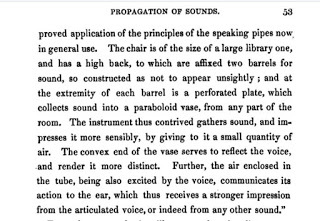
Mr. William Mullinger Higgins’s Philosophy of Sound and Musical Composition (1838), whose relevant pages I show above, contains the shortest and easiest-to-understand explanation I came upon.
You can learn more of the technical details in the Mechanics’ Magazine of January 14, 1837 here .
Another illustration (of the chair at home) and explanation appeared in The Mirror of Literature, Amusement, and Instruction on 18 February 1837 here .
Clicking on the image will enlarge it. Clicking on the caption will take you to the source, where you can learn more and enlarge images as needed.
Published on January 25, 2016 21:30
January 24, 2016
From the Archives: Big Furry Mittens from the 19thc.
 Isabella reporting,
Isabella reporting,I live outside of Philadelphia, one of the areas hit hardest this weekend by the blizzard known as Winter Storm Jonas (and why do the Weather Powers That Be feel the necessity to name storms?) As we dig out from 29" of snow plus drifts, I remembered this post, and thought about how much harder this all would have been in the 19th c., when these furry mittens were first worn.

They're made from buffalo leather and likely buffalo hide (the museum that owns them isn't quite certain about the fur/hair, but it does look the same as the popular shaggy buffalo coats and robes from the same era), and they would have qualified as serious cold-weather wear. Mittens are always warmer than gloves because the fingers are kept together. But there's a definite trade-off between warmth and dexterity, as anyone who has tried to do much of anything wearing mittens can attest.
But I'm guessing these mittens had a specific purpose. Stage, coach, and sleigh drivers were a hardy breed. The position required skill with horses, knowledge of the roads, and the necessary strength to drive and control a team of horses in all weather and on all kinds of roads. Driving in winter weather must have been especially cruel. The painting, right, shows the English Dover to London coach laboring through a snow storm, while the one, lower left, features a pair of Canadian sleighs, one having driven the other off the road.

North American drivers often wore long, gauntlet-style mittens like these for extreme weather. The extended cuffs stretched over the sleeves driver's coat, protecting his hands and forearms from driving snow and wind, while the leather palms could securely hold the reins. The mittens would have to have been removed to make any adjustments to the harnesses, but during a long, cold drive, they must have offered a welcome warmth - and probably made quite the style-statement at stage posts and inn yards.
I spotted these mittens on the The Clothing Project, a tumblr devoted to the clothing collections of the Fenimore Art Museum and the Farmers' Museum. Many unusual American pieces here, and worth checking out!
Top left: Men's Mittens, 19th c., Bison Hide & Fur, Farmers' Museum, Cooperstown, NY. Photo by The Clothing Project.
Right: London to Dover Coach, Winter, by Henry Alken, private collection.
Lower left: Run Off the Road in a Blizzard, by Cornelius Krieghoff, c 1850, Art Gallery of Ontario.
Published on January 24, 2016 21:00
January 23, 2016
Breakfast Links: Week of January 18, 2016
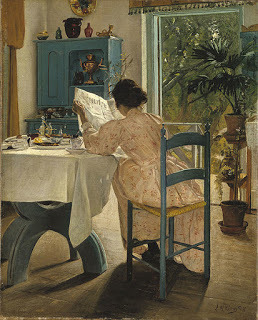 Breakfast Links are served - our weekly round-up of fav links to other web sites, articles, blogs, and images via Twitter.
Breakfast Links are served - our weekly round-up of fav links to other web sites, articles, blogs, and images via Twitter.• Time to get out your ice skates: Gillray's Elements of Skating, 1805.
• The great rocking chair riots of 1901 in New York's Madison Square Park.
• Image: Jane Austen's writing desk.
• The world's first hunk : why we're obsessed with muscle-men.
• A squash does in fact hold dried blood of beheaded Louis XVI.
• Falkirk tartan is oldest in Britain, dating back to Roman times.
• The ideal marriage , according to novels (and it's male writers who tend to portray love as something mysterious and irrational.)
• Image: Portrait by self-taught itinerant painter Ammi Phillips, c1815.
• Oh, red shoes ! Red pumps with moosehair embroidery, c1850-1870.
• This is wonderful: What Estella saw.
• More similar than you'd think: how Victorian daily habits compare to ours today.
• Make-up and medicine in the Middle Ages.
• This 19hc French policeman's amulet includes a piece of a hangman's rope and a dried slice of a murderer's skin.
• Big Hair of the 1960s in snapshots.
• Check out the on-line exhibition for the MuseumFIT's Denim: Fashion's Frontier - including a pair of 1830s denim work pants.
• If, like most of us, you can't get to Glasgow for the Century of Style exhibition, you can still download the app.
• Image: Vintage London underground poster.
• Are you (or your daughter, or granddaughter) part of the Felicity generation?
• Ogling another man's girl in 1912 cost a NY salesman his life.
• A tailor looks for customers so he can support his "very distress'd Family," 1766.
• Pye Corner : flames, poltergeists, and bodysnatchers.
• Mud hovels , mean houses, and natural philosophy in early 19thc India.
• Image: F.Scott Fitzgerald's financial ledger for 1925.
• Fashion never sleeps: looking back at the last time wearing pajamas in public was in style.
• The " virgin's disease " that could only be cured by sex.
• David Bowie in historical costume.
Hungry for more? Follow us on Twitter @2nerdyhistgirls for fresh updates daily.
Above: At Breakfast by Laurits Andersen Ring. Private collection.
Published on January 23, 2016 14:00
January 21, 2016
Friday Video: 100 Years of Workout Style
Isabella reporting,
It's the third week of January, which means that most of those New Year's fitness resolutions have already gone by the wayside, and you're ready for a little fun fashion history. Even if you're still heading off to the gym five days a week, you'll find this week's short video entertaining. While the video features the specialized clothing that American women have worn over the last century for exercising, it highlights some of the more foolish fads in exercise as well. Thighmaster, anyone?
Published on January 21, 2016 21:00
January 20, 2016
Panorama of the Thames
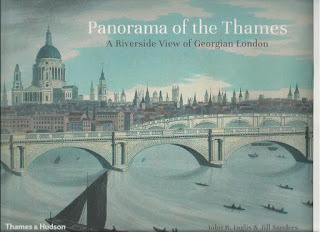 Loretta reports:
Loretta reports:“In 1829 a very unusual book was published, containing just two pages. One opened out into a panorama sixty feet (eighteen metres) in length, the other to just six feet (two metres). The work was called Panorama of the Thames from London to Richmond, and was published by Samuel Leigh, a well-respected London bookseller with premises in the Strand.”—John R. Inglis & Jill Sanders, Panorama of the Thames: A Riverside View of Georgian London
I’ve used Mr. Leigh’s London guides as resources for many of my books. In their advertisements I’d come upon mouth-watering descriptions of publications I was unable to find online. Or anywhere.
Imagine my Nerdy History Girl excitement in November when I learned that the Panorama had recently been painstakingly scanned and cleaned up and made into a book!
Sadly, even the UK edition came out too late (U.S. edition will be out in February) for
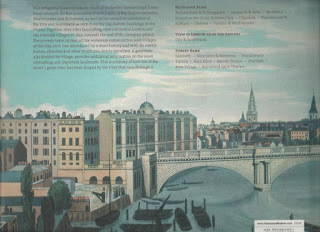 Dukes Prefer Blondes
research, because I would have loved to have had such beautiful details of, for instance, Richmond, and in particular “Mr. Palmer’s” house—now known as Asgill House—the inspiration for Ithaca House in my story. However, I know it will be useful in future books, along with being simply a feast for Nerdy History Girl eyes.
Dukes Prefer Blondes
research, because I would have loved to have had such beautiful details of, for instance, Richmond, and in particular “Mr. Palmer’s” house—now known as Asgill House—the inspiration for Ithaca House in my story. However, I know it will be useful in future books, along with being simply a feast for Nerdy History Girl eyes. You can read about the making of the new book as well as the entire Thames Panorama project here and you can see a lovely video here .
For more images and details, please see the London Historians’ Blog here .
Note: I bought this book with my own money, so no disclaimers are necessary.
Please click on images to enlarge.
Published on January 20, 2016 21:30
January 18, 2016
A Miniature 18thc Fashion Merchant - in Porcelain
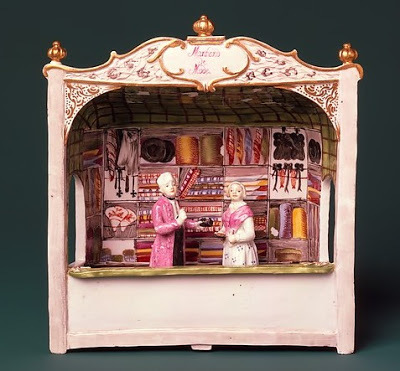 Isabella reporting,
Isabella reporting,Clues to life in the past can turn up in unexpected places. Discovering the interiors of long-ago shops for our characters to visit has always been a particular challenge for Loretta and me. While there are prints and a few paintings that show shop interiors, descriptions can be maddeningly vague. Just as today, shops were so ordinary and commonplace that few people sat down and described them in detail in letters or diaries. When was the last time you documented your local Target for posterity?
All of which is why I found this little (only about six inches high) porcelain so delightful. According to the sign on the front, it shows a marchand de mode, or fashion merchant, complete with a well-dressed shopkeeper ready to serve his customers. I'm not quite sure if the woman represents a customer, or a shop assistant; while the man is firmly behind the counter, her body ends vaguely right on top of it.
The diversity of the goods on the shelves makes me think this is something of a milliner's shop - that is, by the 18thc definition, it contains a variety of small, fashionable goods instead of just hats. There are hats, hanging on the wall, but there are also handkerchiefs and bolts and bolts of fabric, in prints and stripes, checks and solids. I think I can also make out cloaks, or perhaps they're some sort of fancy-dress dominos in the upper left.
Then there are items that I'll have to guess as to their purpose. The cone-shaped items with the red
decoration may be the shields that people held up to protect their faces while their hair was powdered, but then again, they could be folding fans. On the right wall appears to be a display of black silk bows with false curls or queues. I'm also not certain about the black crosses on ribbons, either; are they necklaces, or rosaries, or something else altogether? I know our readers are a well-informed bunch, so if you know better than I, please let me know!
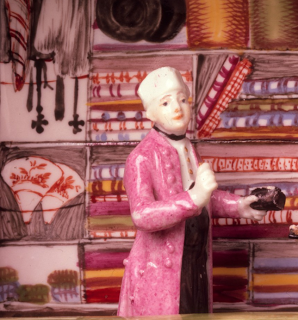
This little shop was made in the Ludwigsburg Porcelain Manufactory, c1765. Apparently the shop was part of a much more elaborate market scene, composed of numerous porcelain shops and figures, and commissioned by Charles Eugene, Duke of Wüttemberg (1728-1793). Apparently the set was inspired by the Duke's visit to Venice, and was used as a table centerpiece for banquets.
Hmm, a formal banquet with an entire Venice street-scene in porcelain strung along the table beneath the candelabra - that sounds like it belongs in a story, too, doesn't it?
Above: Venetian fair shop with two figures, Ludwigsburg Porcelain Manufactory, 1765, Metropolitan Museum of Art.
Published on January 18, 2016 21:00



